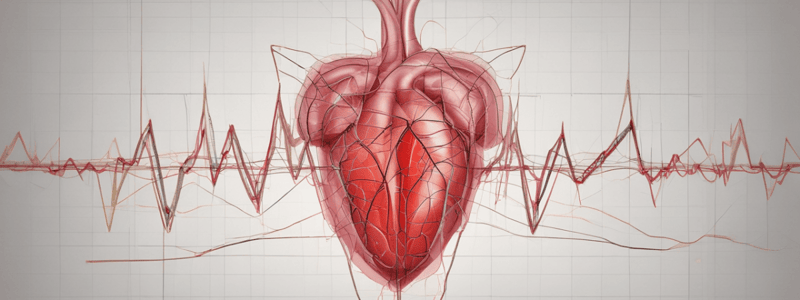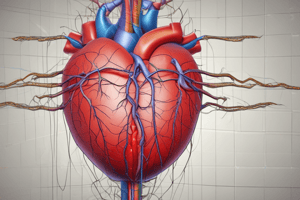Podcast
Questions and Answers
What is the significance of the J point in an ECG?
What is the significance of the J point in an ECG?
- It is the point where the ST segment becomes elevated in normal individuals.
- It is used to determine if the ST segment is isoelectric or elevated. (correct)
- It is the point where the T wave starts.
- It is the point where the QRS interval begins.
What does a widening of the QRS interval indicate?
What does a widening of the QRS interval indicate?
- Delayed repolarization of the ventricles.
- Abnormal depolarization of the atria.
- Ventricles are delaying depolarisation. (correct)
- Conduction delay in the AV node.
What is the significance of a change in the height or amplitude of an ECG wave?
What is the significance of a change in the height or amplitude of an ECG wave?
- It is a sign of cardiac conduction delay.
- It is a normal variation in ECG waveform.
- It indicates a pathological issue has arisen. (correct)
- It is a normal response to exercise.
What is the purpose of chest leads in an ECG?
What is the purpose of chest leads in an ECG?
What does the QT interval represent in an ECG?
What does the QT interval represent in an ECG?
What is the significance of the PR interval in an ECG?
What is the significance of the PR interval in an ECG?
Which of the following electrodes acts as a ground electrode in tracings/views?
Which of the following electrodes acts as a ground electrode in tracings/views?
What is the relationship between Lead I, Lead II, and Lead III?
What is the relationship between Lead I, Lead II, and Lead III?
Which of the following leads covers the high lateral wall of the left ventricle?
Which of the following leads covers the high lateral wall of the left ventricle?
What is the area of the heart covered by the precordial chest lead V1-V2?
What is the area of the heart covered by the precordial chest lead V1-V2?
What is the characteristic of the R wave in the ECG waves from V1-V6?
What is the characteristic of the R wave in the ECG waves from V1-V6?
What is the characteristic of the S wave in the ECG waves from V1-V6?
What is the characteristic of the S wave in the ECG waves from V1-V6?
Which of the following leads is opposite to lead I, II, and III?
Which of the following leads is opposite to lead I, II, and III?
What is the placement of the precordial chest lead V3?
What is the placement of the precordial chest lead V3?
Which of the following leads cover the inferior wall of the heart?
Which of the following leads cover the inferior wall of the heart?
What is the relationship between the bipolar limb leads and Einthoven's triangle?
What is the relationship between the bipolar limb leads and Einthoven's triangle?
What is the primary function of the cardiac cycle?
What is the primary function of the cardiac cycle?
Which of the following statements is true regarding the P wave?
Which of the following statements is true regarding the P wave?
What is the purpose of the electrodes in an ECG?
What is the purpose of the electrodes in an ECG?
What is the significance of the P-R segment in an ECG?
What is the significance of the P-R segment in an ECG?
What is the sequence of depolarisation in the cardiac conduction system?
What is the sequence of depolarisation in the cardiac conduction system?
What is the purpose of Lead II in an ECG?
What is the purpose of Lead II in an ECG?
What is the significance of the S-T segment in an ECG?
What is the significance of the S-T segment in an ECG?
What is the relationship between the direction of the current and the deflection on an ECG?
What is the relationship between the direction of the current and the deflection on an ECG?
Flashcards are hidden until you start studying
Study Notes
ECG Waves
- T wave: ventricular repolarization, with action potential durations shorter in the anterobasal region
- Negative charge moving towards the negative electrode gives a positive deflection after a short period of time
- U wave may be present due to delayed repolarization of papillary muscles and chordinae tendinae
ECG Waves and Cardiac Cycle
- PR interval: conduction of AV node
- Conduction delay/block elongated: links to PR interval
- Widening of QRS interval: ventricles are delaying depolarization
- ST segment: should always be isoelectric (conditions like MI could stop the straight line showing)
- J point: used to determine if the ST segment is isoelectric or elevated
- QT interval: indicates the entire depolarization and repolarization of ventricles
ECG and Electrodes
- ECG can be recorded by limb electrodes or including chest electrodes
- 12 lead ECG: 12 views of the heart
- Chest leads: 6 electrodes giving 6 tracings/views (horizontal plane)
- Unipolar leads: only have positive electrodes
- Limb leads: 4 electrodes giving 4 tracings/views (frontal plane)
Impulse Conducting System of the Heart
- Cardiac cycle relies on wave of excitation spreading across the myocardium in a sequential process
- Depolarizing (+ve) current is generated in SA node
- Spreads to atrium and then to the AV node
- From the AV node, the +ve current moves to bundle branches depolarizing the interventricular septum
- The +ve current then moves to the purkinje fibres depolarizing the ventricles
ECG Graphical Representation
- Captures the electrical activity of the heart (movement of currents)
- Graphical representation of electrical activity of the heart
- The electrodes placed in the body capture movement of ions and record it
- +ve current moving towards +ve electrode will give a +ve deflection
- +ve current moving away from +ve electrode will give a -ve deflection
- +ve current moving perpendicular to the electrodes will give isoelectric line
Normal ECG
- Lead II: most commonly used to produce the sinus rhythm tracing (rhythm strip)
- P wave: formed by atrial depolarization
- P-R segment: 0.1s delay in conduction in AV node leading to P-R segment
- Q wave: septal depolarization
- R wave: ventricular (apex) depolarization
- S wave: ventricular wall depolarization
- QRS complex: ventricular depolarization
- S-T segment: entire ventricular myocardium is depolarized and is not repolarized yet
Limb Leads
- Three bipolar limb leads: Lead I, Lead II, and Lead III
- Lead I: LA (+) to RA (-)
- Lead II: LL (+) to RA (-)
- Lead III: LL (+) to LA (-)
- Leads I, II, and III can be represented schematically in terms of a triangle, called Einthoven's triangle
- The area of heart covered by the leads:
- Lead I: high lateral wall of left ventricle
- Lead II and III: inferior portion of right and left ventricle
Unipolar Limb Leads
- The abbreviation 'a' refers to augmented; V to voltage/vector; and R, L, and F to right arm, left arm, and left foot (leg) respectively
- The area of heart covered by:
- aVR: right ventricle and basal septum
- aVL: high lateral wall of left ventricle
- aVF: inferior wall of the heart
Precordial Chest Leads
- In horizontal/transverse plane
- Placement: V1 to V6
- The area of heart covered by:
- V1-V2: right ventricle
- V2-V3: basal septum
- V2-V4: anterior wall of the heart
- V5-V6: lateral wall of the heart
- The ECG waves:
- R wave increases in size from V1-V6
- S wave decreases in size from V1-V6
Studying That Suits You
Use AI to generate personalized quizzes and flashcards to suit your learning preferences.




